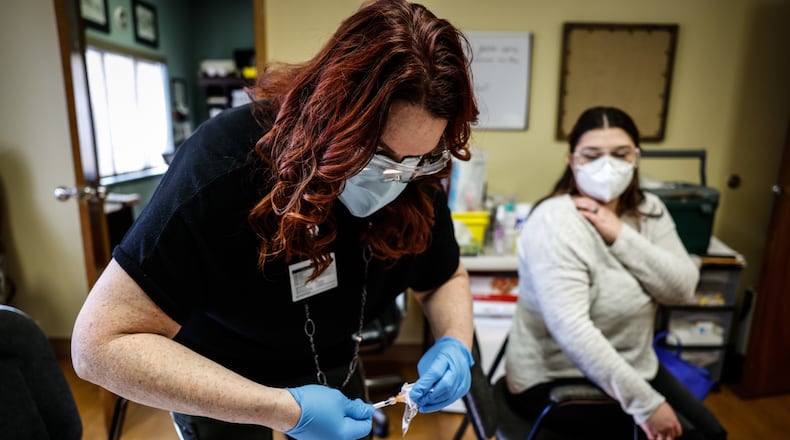“Looking at COVID-19, Ohio’s case numbers this fall declined from a late summer increase, but I want to caution us not to get complacent as the disease continues to cause hospitalizations and deaths across the state,” said Dr. Bruce Vanderhoff, director of the Ohio Department of Health.
For Montgomery County, 2024 will likely be the first year since the start of the COVID-19 pandemic with fewer than 1,000 hospitalizations and 100 deaths. There were 916 hospitalizations and 62 deaths due to COVID-19 reported between Jan. 1-Dec. 26, 2024, according to the most recent data from ODH.
Year-to-date comparisons between Jan. 1 through Dec. 26 of 2023 and 2024 in Montgomery County show a 45% decline in hospitalizations and a nearly 49% decline in deaths.
Butler County saw 270 hospitalizations and 36 deaths due to COVID-19 between the beginning of 2024 and the most recent week of data. Clark County had one hospitalization and 19 deaths of county residents this year. Greene County had 177 hospitalizations and 22 deaths.
| County | 2020 | 2020 | 2021 | 2021 | 2022 | 2022 | 2023 | 2023 | 2024 through Dec. 26 | 2024 through Dec. 26 |
|---|---|---|---|---|---|---|---|---|---|---|
| Hospitalizations | Deaths | Hospitalizations | Deaths | Hospitalizations | Deaths | Hospitalizations | Deaths | Hospitalizations | Deaths | |
| Butler | 766 | 402 | 1,187 | 554 | 1,033 | 277 | 404 | 61 | 270 | 36 |
| Champaign | 89 | 35 | 141 | 77 | 73 | 47 | 3 | 9 | 2 | 5 |
| Clark | 279 | 207 | 181 | 235 | 99 | 172 | 3 | 42 | 1 | 19 |
| Darke | 253 | 95 | 185 | 104 | 116 | 49 | 17 | 8 | 57 | 5 |
| Greene | 528 | 165 | 650 | 254 | 596 | 122 | 182 | 25 | 177 | 22 |
| Miami | 351 | 131 | 769 | 256 | 429 | 123 | 147 | 24 | 123 | 17 |
| Montgomery | 2,958 | 703 | 4,715 | 896 | 3,584 | 583 | 1,734 | 125 | 916 | 62 |
| Preble | 181 | 71 | 271 | 94 | 204 | 41 | 63 | 7 | 45 | 4 |
| Warren | 479 | 203 | 521 | 280 | 343 | 159 | 120 | 27 | 124 | 11 |
| All Ohio | 37,206 | 13,621 | 51,409 | 18,277 | 32,264 | 9,329 | 11,975 | 2,169 | 7,480 | 1,150 |
Globally, from the start of the pandemic until Nov. 10, 2024, more than 776.8 million confirmed COVID-19 cases and more than 7 million confirmed deaths were reported to the World Health Organization across 234 countries.
While there is still room for improvement, COVID-19 hospitalizations and deaths have continued to see significant declines year over year. The majority of COVID-19-associated deaths happened in 2020, 2021 and 2022. Increased immunity from infection or vaccination resulted in a significant decrease in deaths since the second half of 2022, the WHO says.
“Even as the virus continues to evolve, we need to remember that it can still cause severe illness and death, particularly among those who are unvaccinated,” Vanderhoff said.
Everyone ages 6 months and older should get the 2024–2025 COVID-19 vaccine, the Centers for Disease Control says. This includes people who have received a COVID-19 vaccine, people who have had COVID-19 and people with long COVID.
“It (the vaccine) can reduce the risk of developing what is known as long COVID, a set of debilitating symptoms that can linger for months or even years after infection,” Vanderhoff said.
An estimated 6% of symptomatic COVID-19 infections result in long COVID symptoms, the WHO says.
Fewer than 10% of Ohioans have gotten the latest COVID-19 vaccine, according to ODH.
“It’s not too late to get vaccinated,” said Dan Suffoletto, public information manager at Public Health - Dayton and Montgomery County.
Vaccines are readily available through health care providers and at many pharmacies. Visit Vaccines.gov to find a pharmacy near you.
About the Author

